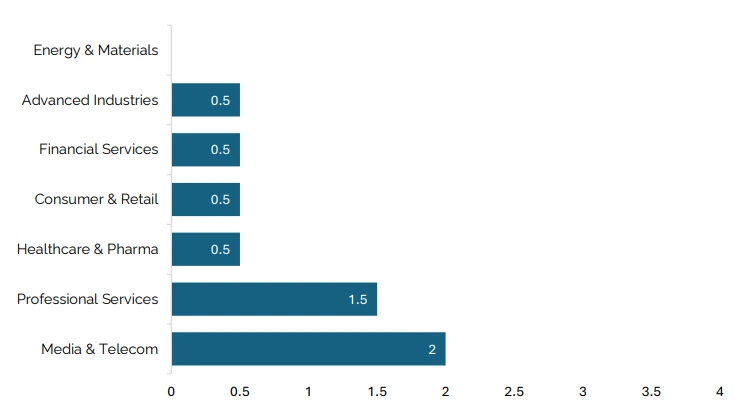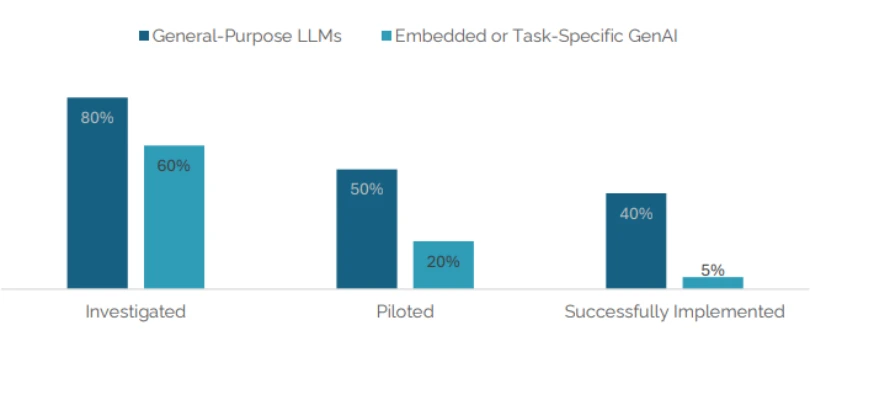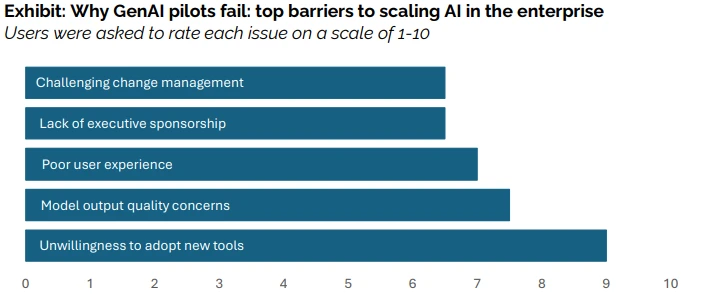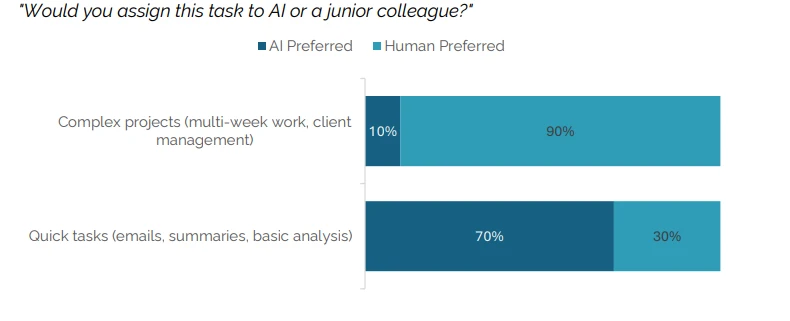A new research report by MIT is giving the corporate world nightmares, but Satyen K. Bordoloi reads between the lines and finds that the ‘shadow AI economy’ is where the real AI story lies.
I have been taking formal and informal talks about AI since 2019. Back then, I had to trigger interest in people about AI. These days, I’m approached to share my insights. The miracle happened after November 2022 when ChatGPT launched. In recent talks I have had with people, including one with the staff of different consulates in Mumbai, one fact has become apparent to me: everyone is fiddling with AI, in their own capacity, without exception.
Yet, if you read the recent MIT Project NANDA report titled, “The GenAI Divide: State of AI in Business 2025,” or reports about it, its headline grabs for the opposite reason. It says at the outset that 95% of generative AI pilots fail to deliver measurable returns. If you read just that, you’ll be convinced that AI has failed in the corporate sector. Yet, when you read the report in depth, you realise that the researchers presented the most sensational bit of their research first, leading to the headlines.
Some of the 26-page report’s insights later are profound and transformative and in line with other reports and what I have personally observed in talks with individuals and groups: an unprecedented grassroots technological AI revolution is taking place under the surface of official initiatives where individual employees, on their own initiative, are harnessing AI to drive productivity, even as corporate efforts on the same fail.

The 95% Failure Hype: The report begins with a bang:
“Despite $30–40 billion in enterprise investment into GenAI… 95% of organizations are getting zero return. The outcomes are so starkly divided across both buyers (enterprises, mid-market, SMBs) and builders (startups, vendors, consultancies) that we call it the GenAI Divide. Just 5% of integrated AI pilots are extracting millions in value, while the vast majority remain stuck with no measurable P&L impact. This divide does not seem to be driven by model quality or regulation, but seems to be determined by approach.”
There you have it – anyone wanting to do a quick write-up on the report will declare AI is a failure. Yet, read beyond the headlines and you’ll see that this first paragraph itself has a truth hidden in plain sight in its last three words, where it says that a company’s success or failure is “determined by approach.” In essence, the 5% companies that have measurable gain are doing something the rest aren’t.
The report’s methodology provides critical nuance. Researchers analysed over 300 public AI initiatives, conducted 52 structured interviews, and surveyed 153 senior leaders. This multi-faceted approach helped them capture not just official projects but also the undercurrent of informal AI use that defines the modern workplace. What this reveals, beyond the attention-grabbing headline, is a tale of two AI economies: one of stalled corporate initiatives and the other of vibrant, employee-driven experimentation. This dichotomy is at the core of the GenAI Divide, largely ignored in favour of sensationalist takeaways.
The report reveals that AI is actually being adopted at an astonishing pace, but this is through informal employee-led channels, leading to a misunderstanding of where AI value is actually being created in the corporate sector.

The Shadow AI Economy: Where AI Actually Works:
The report found that although only 40% of companies have purchased official large language model (LLM) subscriptions, employees at 90% of companies regularly use AI tools at a personal level, like ChatGPT and Claude, for work. Indeed, nearly every knowledge worker surveyed for the report said they used LLMs in some form for their daily work, often multiple times throughout their workday.
If you really think about it, this underground adoption might be the fastest enterprise technology adoption in corporate history, outpacing even the early spread of email, smartphones, and cloud computing. Because when it comes to generative AI, workers aren’t merely experimenting; they’re relying on these tools for a good part of their jobs. They are automating routine tasks, accelerating research for their projects, and using it for communication.
Recently, I met an employee in an analysis firm in Mumbai whose job is to give insights from the data that is dumped on him by clients. Instead of doing all the ‘gadha majuri’ (donkey’s labour) himself, he said he used an off-the-shelf gen AI tool to do the rudimentary analysis, which he then adopted, modified, and checked before doing his final report. And I am sure you all have seen people in WhatsApp chats use it to reply to messages these days with wording so perfect, you smell an LLM rat.
Now, take a corporate lawyer quoted in the same MIT report who exemplifies this. Her organisation has invested $50,000 in a specialised AI contract analysis tool. Yet, what she finds most value in is a generalised tool like ChatGPT in her drafting work because “the fundamental quality difference is noticeable” as “I can guide the conversation and iterate until I get exactly what I need.” She further adds: “ChatGPT consistently produces better outputs, even though our vendor claims to use the same underlying technology.”
Yet, this very fact, i.e. how a $20-per-month general-purpose tool outperforms specialised enterprise systems costing exponentially more, has been given lower preference over the sensationalist headlines. This is the most important finding, it’s most crucial paradox and highlights why most organisations remain on the wrong side of the GenAI Divide.

The Learning Gap: Why Enterprise Tools Fail:
At the heart of this lies what MIT researchers term the “learning gap”, i.e. the inability of most enterprise AI systems to retain feedback, adapt to context, or improve over time. This explains why expensive custom solutions are failing even when consumer tools thrive. Users reported that enterprise tools “don’t learn from our feedback” and require “too much manual context required each time,” making them feel rigid and static compared to their flexible off-the-shelf counterparts.
The report finds that this learning gap creates a strange paradox in user preferences. For quick tasks like emails and basic analysis, “70% prefer AI” over human colleagues. But for complex, high-stakes work, 90% still want humans. The dividing line isn’t intelligence; “isn’t intelligence, it’s memory, adaptability, and learning capability.” Consumer tools like ChatGPT succeed because they feel responsive and flexible, even though they reset with each conversation, something which enterprise AI tools fail to do.
The report finds that this is the critical differentiator between organisations stuck on the wrong side of the GenAI Divide, i.e. the 5% who’re raking millions worth of advantage over those who’re gaining zero. Successful implementations focus on systems that learn and remember, whether through agentic AI workflows with persistent memory or vertical SaaS solutions deeply customised to specific workflows. This emphasis on adaptive capability, rather than raw model intelligence, is, I think, another important but less discussed finding of the MIT research.

Strategic Partnerships: Why Buying Beats Building:
Another important tech wisdom the report challenges is that external partnerships succeed twice as often as internal builds. Many enterprises rush to develop proprietary AI solutions, yet the report shows that externally sourced tools reached deployment 67% of the time, compared to just 33% for internally built tools. This contradicts the common assumption that in-house development means better customisation and control.
The other important finding is that most successful companies approached AI procurement not as traditional software purchases (the fill it, shut it, forget it model) but as strategic partnerships similar to BPO relationships. These companies demanded deep customisation aligned to internal processes, held vendors accountable to business outcomes rather than technical benchmarks, and partnered through early-stage failures, treating deployment as a co-evolutionary process. They prioritised vendors who demonstrated a deep understanding of their workflows and could offer systems that integrated with existing tools and could adapt over time.
This shift from building to buying is a fundamental rethinking of AI implementation. Successful organisations recognise that the challenge isn’t just acquiring technology but accessing specialised expertise and adaptive systems that can evolve with their needs, as the report notes, “The window for crossing the GenAI Divide is rapidly closing” as enterprises begin locking in relationships with learning-capable vendors, creating significant switching costs that compound monthly 13.
The Real ROI in Unglamorous Places
The report shows a dramatic misalignment in where companies invest their AI budgets and where they are getting the most significant returns. About 50% of AI budgets are being allotted to sales and marketing applications when the highest ROI is coming from back-office automation of functions like procurement, finance, and operations.
These unglamorous, yet critical areas, are delivering remarkable cost savings: companies reported saving $2-10 million annually by eliminating business process outsourcing contracts and cutting external agency costs by 30%.
Now, what is fascinating is that these gains were achieved “without material workforce reduction.” Instead of firing employees, organisations that replaced expensive outside services with AI, accelerated work without changing team structures or budgets, and their ROI came primarily from reduced external spend. This means that while sales and marketing applications capture attention and investment, it is back-office automation like customer service, operations, finance and legal, etc., that gives greater and sustainable returns for organisations who are willing to look beyond obvious use cases.

Industry Realities: Why Cautious Adoption Isn’t Failure
Another issue with the media coverage of this report is that it overlooked its nuanced findings on industry-specific adoption. While only technology and media sectors have shown meaningful structural disruption, seven other major industries – including healthcare, finance, and manufacturing have shown “significant pilot activity but little to no structural change.” This measured approach isn’t necessarily failure or that they are lagging; it is just that they are making strategic choices in favour of stability and incremental change because of their high-stakes environments.
Take healthcare and energy, where “most executives report no current or anticipated hiring reductions over the next five years.” They are prioritising careful implementation over quick disruption because regulatory constraints and safety requirements demand these deliberate approaches. Technology and media are adopting so fast; over 80% executives anticipate reduced hiring within two years, because of both their greater risk tolerance and more obvious use cases.
But even industries with lower disruption scores aren’t necessarily lagging. As a manufacturing COO quoted in the report noted: “We’re processing some contracts faster, but that’s all that has changed.” This gradual but sustainable improvement multiplied across thousands of tasks and workers over the months and years may not look flashy, but it will ultimately prove more valuable.
For organisations currently unsuccessful in AI adoption, the path forward requires them to make a fundamentally different choice about technology, partnership, and organisational design. They need to stop investing in static tools that require constant prompting and partner with vendors who offer custom systems. They must focus on workflow integration over flashy demos. And of course, they must stop spending on building AI tools in-house.
The flashy headlines picked from the MIT NANDA report declare that the AI revolution is failing. The truth is the reverse, as I have personally discovered over the last 2 years. The revolution is quietly occurring in the daily workflows of nondescript employees who, on their own, have already figured out how to make AI work.
In case you missed:
- OpenAI, Google, Microsoft: Why are AI Giants Suddenly Giving India Free AI Subscriptions?
- The B2B AI Revolution: How Enterprise AI Startups Make Money While Consumer AI Grabs Headlines
- From Generics to Genius: The AI Revolution Reshaping Indian Pharma
- AI Adoption is useless if person using it is dumb; productivity doubles for smart humans
- Rogue AI on the Loose: Can Auditing Uncover Hidden Agendas on Time?
- Why the Alleged, Upcoming AI Crash Is Never Going To Happen
- Zero Clicks. Maximum Theft: The AI Nightmare Stealing Your Future
- Deep Impact: How Cheap AI like DeepSeek Could Upend Capitalism
- The Growing Push for Transparency in AI Energy Consumption
- The Great AI Browser War: When AI Decided to Crash the Surfing Party










